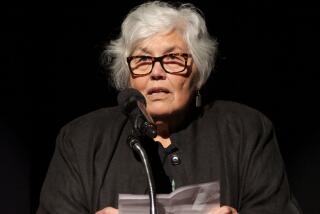From the Archives: 3-Time Oscar Winner Ingrid Bergman Dies
Ingrid Bergman, the unaffected Swedish girl whose film roles enchanted two generations and won her three Academy Awards, died late Sunday—her 67th birthday—at her London home after an eight-year battle with cancer.
The actress, whose ethereal features enraptured audiences, and whose courage and dedication brought her to triumph over personal scandal and professional turmoil, had undergone a mastectomy in 1974 and again in 1978.
With her when she died in her Chelsea apartment was her third husband, Lars Schmidt, from whom she was divorced.
Started as an Extra
The commitment she showed to her craft never waned—from her first part as an extra in a 1933 Swedish film, where she earned $1, to her final performance, as Israeli Prime Minister Golda Meir, in the 1981 television production “A Woman Called Golda.”
“Golda” executive producer Harve Bennett recalled Monday that she worked “in constant pain. At night she was forced to sleep with her hand in traction above her head, to keep the swelling from disfiguring her on camera. But she never complained.”
To the end, her charm—which once prompted a critic to describe her as “an intelligent orchid”—and her desire to make her life “a wonderful experience” carried her through, smoking cigarettes and drinking champagne as usual, fighting illness as she had warred and triumphed over scandal 30 years before.
It was the same vigor and enthusiasm that astonished directors and co-workers, and which led her, in six years’ time, to become one of Hollywood’s immortals. The moviegoers who flocked to her films—and whose acclaim made her one of the most popular actresses of her time—did not see the effort, but they adored the results.
Miss Bergman came to Hollywood in 1939 as an unknown Swedish ingenue—producer David O. Selznick called her his “healthy Swedish cow.” At 5 feet 8 inches, big-boned and blue-eyed, she was a strapping woman who refused to conform to Hollywood image-making. She wore the same dress to the Academy Awards ceremony two years running. Her one concession was to buy the Hollywood uniform, a mink coat, “to throw on the bed at parties.”
But she refused to change her name, wear layers of makeup, fix her teeth or pluck her eyebrows and told Selznick that if he insisted, “I’ll take the next train and go back home.”
She didn’t, and Selznick later prided himself on creating the first “natural actress,” an image that carried her into refreshing, vivid roles well into maturity.
And from the very first, she made an unforgettable impact on American audiences who, weary of plucked and painted vamps, took her to their hearts.
From her first screen appearance here in the poignant “Intermezzo,” through the slapdash production of the now-classic “Casablanca,” the baseball-playing nun in “The Bells of St. Mary’s,” the minxlike Clio Dulaine in “Saratoga Trunk” and the visionary saint in “Joan of Arc,” Miss Bergman’s flawless profile was placed opposite Hollywood’s most disparate types—Leslie Howard, Humphrey Bogart, Gary Cooper.
In her first nine years in Hollywood, she made 14 movies and a running Hollywood gag of the mid-1940s was, “Do you know, last night I actually saw a film without Ingrid Bergman in it?”
Married and with a small daughter, she tried to live as privately as possible. But her work enthralled the public. When she cropped her hair to play Maria in “For Whom the Bell Tolls,” thousands of women rushed out for haircuts. When she played a cheerful Sister Mary Benedict in “The Bells of St. Mary’s,” so many girls rushed to take the veil that their parents wrote to her, complaining that her sympathetic portrayal of the religious life was depriving them of grandchildren.
(What she loved best about the nun’s role, Miss Bergman confessed in her 1980 autobiography, “My Story,” was that she could give up her eternal diet. “All it (the voluminous nun’s habit) showed was my face. I could eat ice cream forever.”)
She eventually made 44 movies, countless stage appearances and two television roles in her 48 years in show business, in a career spanning two continents and five languages.
Her Academy Award-winning films followed the evolution of her professional and personal maturity—from “Gaslight,” in 1944, as a tormented Victorian wife; to “Anastasia,” in 1956, where she played an amnesiac Russian grand duchess who comes into her own; to “Murder on the Orient Express” in 1974, where she portrayed an aging and insular Swedish missionary.
Her film roles mirrored her career image as it changed from the sweet woman dominated by strong men, to a budding independence, to a sense of insight and strength epitomized by her performance as Golda Meir.
That strength brought her through what was called, at the time, “the scandal of the century.” In 1948, at the peak of her career, she had written to Italian neo-realist director Roberto Rossellini, praising his work and volunteering to do a movie with him. The only words she knew in Italian, she warned, were “I love you.” Rossellini turned to a friend and asked, “Well, who is this Ingrid Bergman?”
But within a year, she had gone to Italy to film his “Stromboli,” had fallen in love, and although married to Dr. Peter Lindstrom had borne Rossellini a son out of wedlock.
(She eventually divorced Lindstrom and married Rossellini and later gave birth to twin girls. Their marriage was annulled in 1958. A year later, she wed producer Schmidt but she and Schmidt were divorced in 1975.)
It was a scandal of unimaginable proportions, in an era when stars, even in married roles, were clad in pajamas and consigned to twin beds. And it burst over the heads of Bergman and Rossellini like a thunderstorm. Her friend, Robert Anderson, said he was at a newsstand in New York and heard the man next to him remark. “So she was just a goddamned whore!”
Their affair had been popular in parts of Italy, where, wrote Miss Bergman, fans would crowd the hotel hallway and “applaud me all the way to the bathroom and all the way back again.” But then newsmen came, and “counted the number of toothbrushes in the bathroom.”
After the boy was born, the condemnation reached a crescendo. On the floor of the U.S. Senate, Colorado Sen. Edwin C. Johnson called Miss Bergman “brazen,” and demanded that she be banned for “moral turpitude,” hoping that “out of Ingrid Bergman’s ashes may come a better Hollywood.” He condemned Rossellini as “a love pirate” and characterized them both as “moral outlaws.” A movie mogul visited Miss Bergman in Italy, and suggested she could return to Hollywood if she gave up Rossellini, put her son in an orphanage, and apologized to Americans on the radio.
“As a matter of fact,” she wrote later, “when the big scandal broke loose, I thought I would have to give up acting—to save the world from disaster—I mean, it seemed that I had corrupted everybody in the world.”
Even in the Soviet Union, where her movies were banned, the satirical journal Krokodil reported the fall from grace of “the only American saint,” whose press photos showed her not in a bathing suit, but in an apron.
A few old friends stuck by her, among them Ernest Hemingway, director Alfred Hitchcock, and actors Cary Grant and Gregory Peck. But the magnitude of the scandal surprised and shook Miss Bergman. “I have always tried to get the most out of life,” she later said ruefully. “Sometimes, though, I discovered the most can be too much.”
Miss Bergman did not return to the United States until 1957, after what she called her “watershed” film, “Anastasia.” She sat in a bathtub in New York, sipping champagne and listening to the radio as Cary Grant accepted the Oscar for her.
A Hollywood Apology
It was Hollywood’s way of making up. Later, she analyzed why Americans were so shocked “If I had not been so loved as I was in America, playing all the good parts, the saints and the nuns, people wouldn’t have become so upset. But I’d betrayed them, you see. They had made an image of me. I think another actress could have gotten away with it easier. They had put me on a pedestal.”
It was a pedestal she never wanted.
Just as she rebelled against the Hollywood image-makers, she rebelled against being typecast. “I could not stay there any longer,” she explained in a 1950 interview, “grinding out pictures in the same pattern all the time. I could not go on playing good and beautiful girls all my life ... I had to act everything.”
She was amused by critics who called her things like “the Palmolive Garbo,” but she wanted to test her versatility. She delighted in her role as the daughter of a Nazi spy in “Notorious,” where her extra-long kiss with Cary Grant passed the film censors. She begged for—and finally got—the role of the saucy prostitute Ivy in “Dr. Jekyll and Mr. Hyde,” instead of the good doctor’s sweet and demure fiancee.
There were other less-than-virginal roles, but the producers, because of the public, had made up their minds about Ingrid Bergman—she could do no wrong.
What capped that image in 1948 was her performance in “Joan of Arc.” She had wanted, and been promised, the role in 1940, but the outbreak of World War II forced a postponement because, as it was explained to her, “the British burned Joan,” and the film might put a bad light on the British-French alliance. (Years after she eventually got to do the film, French customs men would greet her in Paris with, “Ah. Jeanne d’Arc, welcome home.”)
Exposed to Rossellini
It was in 1948 that she saw her first Rossellini film, “Open City,” and after Hollywood’s full-blown theatricality, she was impressed by its starkness. “Here were we, still making full-costume period pieces at great expense, and there suddenly was a film about modern Italian life, with no makeup, no costume, as though the director had just taken out a wall and was photographing real life. It stunned me.”
That sort of zeal to explore the limits of her talent and versatility had been part of Miss Bergman’s life before anyone outside her family had ever heard of her. “I don’t think,” she said of actors, “they should try to live like Mrs. Jones in her little house with her humdrum life and limited ideas. Actors should get everything they can out of life.”
Her mother had died when she was 3, and her acting—the imaginings that come with being a lonely child—began early. When she went walking with her adored father, a free-spirited photographer who died when she was 13, she would even trot along behind him, pretending to be a dog, stopping to lift her leg toward convenient trees.
After her acceptance into the Royal Dramatic School in 1933, she made it a habit to stop at his grave, as she had for her first film audition, to pray for help. And after each scene, she told herself, “I think I’ll be better later.”
She was. She came here in 1939, a veteran of 10 Swedish films, “discovered” by Selznick, whose wife had heard about Miss Bergman’s performance in a Swedish version of “Intermezzo” from a Swedish bellboy in a New York hotel.
So anxious was Selznick that she make a “sensational” film debut in “Intermezzo,” in 1939, that the understated opening scene, where she enters an apartment and hangs up her hat and coat and stands in the doorway, was re-shot 30 times. In not one of those “takes” did the director notice that Miss Bergman’s nose was shiny.
But shiny nose and all, her career skyrocketed. After a brief return to Sweden, she performed on Broadway with Burgess Meredith in “Liliom”—a performance so highly acclaimed that no one told her until later that she was mistakenly given the part, instead of another Swedish actress.
It was “Casablanca,” made in 1942, that was to give Miss Bergman the sure grip on the emotional heartstrings of young filmgoers today, a grip she never relinquished. The film was a slapdash affair, with the script half-finished and end uncertain. Humphrey Bogart retreated to his dressing room after every scene. “I kissed him,” she said, “but I didn’t know him.”
But somehow, the uncertainty in its making conveyed on screen the quicksand fortunes of war and love, and the tragic, stricken face of llse as she stood on the airport runway, saying goodby to Bogart so she could leave with Paul Henried, has imprinted itself indelibly on moviegoers for 40 years. (On Monday. Henried—the only survivor of the famous trio—called her “a lovely lady, a wonderful actress, a dear friend . . . . I don’t think she was taken by her beauty. She was taken only by the desire to do the best work possible in her profession.”)
Her ambition to excel contributed to the breakup of her marriage to Rossellini, after four unsuccessful movies together. It was a tempestuous breakup, with raging custody disputes over the children.
But it did not keep Miss Bergman off stage. “If you were to take the stage away from me, I would stop breathing,” she once said. From European theaters, she returned to the United States in 1957, and to Hollywood in 1959, to be a presenter at the Academy Awards. She returned that night to applause more tumultuous than for any Oscar winner.
Busy, Varied Schedule
Her schedule after that was as busy as it was varied—a CBS television drama, a TV version of “Hedda Gabler” with Sir Ralph Richardson, stage plays, and more films, inluding “Cactus Flower,” “The Yellow Rolls-Royce,” and “A Walk in the Spring Rain.”
Her best supporting actress Oscar came in 1975, for “Murder on the Orient Express,” but her performance as a successful pianist but disillusioned mother in lngmar Bergman’s 1979 film “Autumn Sonata” was her last movie—and one of her most critically acclaimed.
After almost 50 years as an actress, Miss Bergman cultivated some very intense beliefs about her craft. She once won the grudging respect of Irish playwright George Bernard Shaw when she told him she didn’t like his depiction of Joan of Arc.
Miss Bergman spent her last days in the English summer, sitting outside her red-brick flat in Cheyne Walk, alongside the Thames.
More to Read
Start your day right
Sign up for Essential California for news, features and recommendations from the L.A. Times and beyond in your inbox six days a week.
You may occasionally receive promotional content from the Los Angeles Times.







